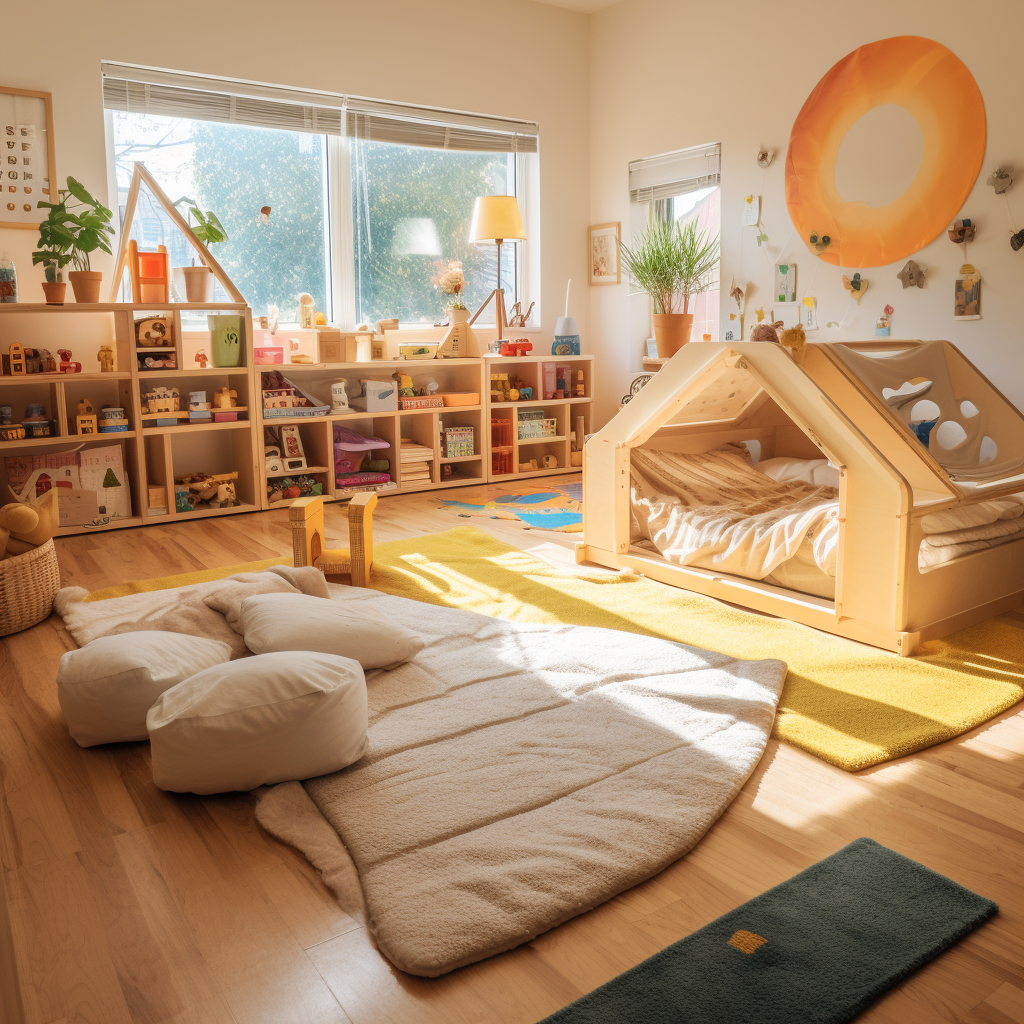Fostering Independence and Healthy Sleep from Infancy Onward
As all parents know, establishing healthy sleep habits in children is critically important but often extraordinarily difficult. Pediatrician-turned-educator Dr. Maria Montessori believed that a thoughtfully prepared sleep environment could empower children to regulate their own sleep cycles. This instills independence and self-sufficiency starting in infancy that pays dividends for years down the road.
Over a century later, Montessori education principles continue gaining mainstream momentum. Yet Montessori’s insightful approach to children’s sleeping spaces remains largely overlooked in the average household. Montessori bedrooms leverage strategic design not just to maintain order but actively provide children the freedom and capability to govern themselves.
Let’s examine core components of the Montessori sleep method, its origins, and its effectiveness in cultivating self-assured, independent kids.
The Montessori Education Method
Maria Montessori pioneered her educational philosophy in 1907, opening the first Montessori school for low-income students in Rome, Italy. Montessori schools operate all over the world today, but even at peak popularity only make up 5 percent of U.S. private schools. However, Montessori classrooms and toys have gone mainstream. Montessori education iscentered around fostering student independence and using developmental stages as the framework for learning.
Montessori environments utilize unique educational tools, hands-on lessons, large open block scheduling, mixed age classrooms, and teacher observers who guide rather than direct learning. The materials and activities offered to students are tailored to individual pace and ability. Classrooms promote movement and cultivate concentration and self-motivation. The overall goal is producing capable, creative problem solvers equipped with organizational skills, independence, and leadership qualities to apply far beyond their schooling years.
Why The Montessori Method Pays Such Close Attention to Sleep
While much attention goes to the specialized tools and freedom of movement in Montessori classrooms, far less examination exists around the Montessori approach to designing children’s’ bedrooms and sleeping spaces. Yet this was equally fundamental. “Sleep knits up the ravelled sleeve of care,” said Shakespeare, poetically capturing what scientists now confirm. Quality sleep proves critical to growth, development, and academic success. Growing research links poor and irregular childhood sleep to issues with:
- Physical Health – Increased risk of obesity, weakened immunity
- Mental Health – Higher rates of depression, anxiety, ADHD symptoms
- Behavior – Difficulty with impulsivity, aggression, hyperactivity
- Cognition – Impaired memory, lower IQ, language delays
- Performance – Worse academic and athletic performance
Montessori argued years before such research emerged that supporting children’s sleep should be paramount. She highlighted sleep as foundational for growth, learning willingness, and development. Montessori classrooms actually include a “sleep corner” where children can curl up with blankets as desired. Mostly deeply, Montessori bedroom layouts, beds, and bedding aim to provide total autonomy so kids connect to natural sleep cues from day one.
The Montessori Bed
If the classroom was one pillar of Montessori education, the sleeping space was another. Traditional Montessori beds consist simply of a thin mattress or mat placed directly on the floor without a bed frame or legs. This enables infants, toddlers, and children up to age 6 access to their bed without needing any help from adults. The ultra-low profile removes risk of injury from falls yet still enables full freedom of motion. Relatedly, Montessori spaces avoid cribs, which restrict mobility and require adult assistance to put a baby into bed. Instead, children transition straight from bassinets into floor beds.
These simple Montessori mattresses allow kids independence in all bedtime activities – getting in and out of bed, covering up with blankets, waking through the night to use the bathroom. Parents can feel assured kids safely access their beds but don’t require middle-of-the-night pickups or calming to go back to sleep. Kids instead listen to bodily cues and govern their own sleep cycles. When paired with a nearby matt for extra sleeping or playing space, children learn to tune into needs, use their environments accordingly, then seamlessly transition back into bed when fatigue sets in.
Montessori Bed Benefits – Responsibility, Independence, Better Sleep Quality
Placing beds on the floor certainly saves parents backs during sheet changes and minimizes risk during the toddler night wanderings phase. However, the Montessori floor bed serves much larger, longitudinal purposes:
Fosters Responsibility and Life Skills – Can your preschooler make his own bed? For kids as young as 18 months, Montessori mattresses set an accessible stage for children to take ownership of bedtime prep and pillowcare. Kids tidy and care for personal spaces, building executive functioning and life skills.
Encourages Confidence and Independence –Floor beds empower even the littlest sleepers to control their sleep environments, rather than requiring parental sleep crutches night after night. Kids learn to self-soothe, make wise choices, and develop resourcefulness around meeting their own biological needs.
Promotes Development – Unconfined sleep setups allow freedom of motion to shift sleep positions for comfort. This benefits growing joints and muscles while also teaching kids to tune into bodily cues. Studies confirm kids get higher-quality, uninterrupted rest without bed railings.
Establishes Healthy Sleep Patterns – Montessori believed children safely given control over their sleep environment learn to recognize natural signals of tiredness. By tapping into biological clocks, kids develop strong circadian rhythms and self-regulation years earlier than parent-directed bedtimes allow.
Montessori Bed Design Principles
Montessori floor beds serve function over form. Yet applying certain design principles creates an environment optimized for cultivating independence:
- Safety – Low bed profile removes risk of falls that could occur on elevated bunks or mattresses. Yet mobility remains unconstrained.
- Simplicity – Avoid loud colors, patterns, or cartoon motifs that overstimulate. Neutral colors and natural wood materials establish order.
- Independence – The bed setup enables free movement in and out of bed so children take ownership of sleep-based choices.
- Responsibility – Kid-friendly bed heights empower children keeping their sleep space tidy.
- Respect – The low bed communicates respect for a child’s capability to self-govern their sleeping environment.
Putting Montessori Sleep Theory into Practice As parents strive to balance busy household management with cultivating capable kids, the Montessori bedroom offers quiet opportunity. While upholding daily sleep schedules challenges most families, the Montessori method delivers an often untapped solution – rather than rule their sleep, release children to rule themselves.
Transitioning to a Montessori Bed:
- Use a crib mattress, tatami mat, or rollout mattress directly on the floor
- Ensure tight-fitted sheets stay secured
- Offer lightweight organic bedding the child can manipulate
- Include kid-sized cleaning tools like dusters, pillow beater
Outfitting a Montessori Bedroom:
- Low open bookcase to inspire reading before bed
- Nightlight, water cup – easy to manage even in darkness
- Dresser they can open and access clothing items
- Wastebasket + cleaning supplies to tidy room
Montessori Bed Alternatives
Montessori made clear no special expensive furnishings required. Her priority remained fostering capability and independence. So while authentic Montessori-brand floor beds exist, parents need not invest to apply the theory.
- Mattress or matt on floor
- Cushions, roll-up pads, or makeshift bedding
- Keep crib but remove front railing
- Place mattress on floor inside crib
- Use toddler bed or cot mattress without bedframe
- Set current bed as low as possible to floor
The core Montessori bed element is its accessibility enabling kids to assume bedtime responsibility. Whether utilizing a basic mat or converting a current toddler bed, placing bedding firmly within a child’s manageable reach delivers the same empowering impact.
What Age Does Montessori Theory Apply? Dr. Montessori designed “Children’s Houses” for kids ages 3-6 years where classroom materials simplified daily living activities to enable independence. However, Montessori classrooms often incorporate “Practical Life Skills” like pouring water, food prep, and using child-sized cleaning tools as early as 18 months old. Montessori believed cultivating independence, movement, and ownership of environments from infancy formed critical developmental windows. Montessori floor beds aim to serve children starting mobility through age 6.
Won’t Kids Play Instead of Sleep? Parents considering the Montessori floor bed often express concern it might invite playing rather than sleeping. However, studies show the opposite outcome. Dr. Montessori argued that allowing kids independence meeting biological needs leads to better quality sleep. The theory suggests children granted freedom at bedtime learn to recognize natural signals of fatigue and regulate rest accordingly.
What If My Child Leaves Their Bed At Night? Montessori advocated for one simple ground rule around nighttime autonomy – children should remain in their bedrooms once put to bed even when rising from the mattress. Kids can read books, access toys, utilize bathroom attached to bedroom but should not wander the full home or awaken parents. Any concerns about safety regarding stairs or siblings can be addressed using light-up stair path markers and baby gates as optional supports.
How Long Should Kids Use Low Montessori Beds?
Montessori classrooms served children from 3-6 years old. However, parents can consider child maturity, independence, and safety in determining what age to transition kids from floor beds to more elevated beds. Typically, Montessori beds adequately serve most children up until at least age 6 though some opt to continue into older childhood.
The Montessori Legacy – Instilling Independence By Design Over a century since Maria Montessori launched her progressive educational approach, science continues upholding the many insights she put forth years before research caught up. Montessori understood the incredible mental and physical changes occurring during early brain development. She believed harnessing this optimal period of growth required careful environmental engineering and close observation more than direct teaching.
While much parenting discourse today focuses on structuring order for children, Montessori took an opposite track – eliminating structure to make space for self-construction. Montessori bedrooms replace confining cribs with open opportunity to move and choose. Rather than train kids to sleep, these intentional environments empower kids to train themselves using developmental instincts we all inherit at birth. This foundation of self-knowledge and intuitive inner discipline cultivates potential far beyond sleeping soundly.
As neuroscience progresses, we continue confirming children thrive when afforded agency over their experiences – active shapers rather than passive observers. For modern parents feeling overwhelmed balancing parental guidance with promoting healthy independence, Montessori offers household inspiration. Thoughtfully prepared spaces provoke kids to channel exuberant energy into skill-building and self-mastery. This fosters emotional intelligence, cultivates problem-solving, and opens lifetime opportunity simply by environment design.
While Montessori schools remain outside mainstream education, Montessori theory offers sage and supportive strategies for parenting from infancy onwards. Providing babies and young kids simple low beds seems small on surface. But ultimately, it proves Montgomery right once more. Carefully designed environments deliver outsized impacts in raising self-assured, independent, capable kids.

